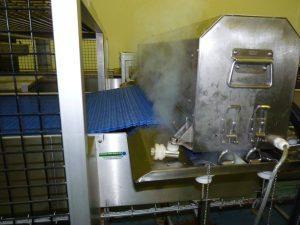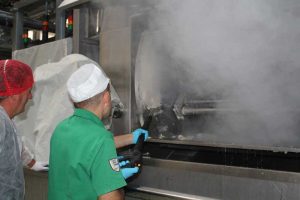One of the key factors in effective conveyor belt cleaning is having knowledgeable and skilled staff members. Proper training ensures that employees understand the importance of cleaning conveyor belts and are equipped with the necessary skills to perform the task efficiently.
Staff training for conveyor belt cleaning offers several benefits. Firstly, trained employees are more likely to follow proper cleaning procedures, which helps maintain the integrity of the belts and prevents damage. They will know which cleaning agents to use, how to handle the equipment safely, and how to identify any potential issues that may arise during the cleaning process.
Secondly, trained staff members can identify signs of wear and tear on the conveyor belts during the cleaning process. This allows for early detection of any potential problems, such as damaged or misaligned belts, which can be addressed promptly before they escalate into more significant issues.
Lastly, staff training promotes a culture of safety in the workplace. Employees who are trained in conveyor belt cleaning understand the potential hazards associated with the task and are more likely to adhere to safety protocols. This reduces the risk of accidents or injuries during the cleaning process.
Benefits of Using Steam Vapour Cleaning Machines
Steam vapour cleaning machines have become increasingly popular for conveyor belt cleaning due to their effectiveness in removing dirt and grime. These machines use high-temperature steam to break down and dissolve contaminants on the surface of the belts.
One of the main benefits of using steam vapour cleaning machines is their ability to remove stubborn dirt and grime that may be resistant to other cleaning methods. The high-temperature steam penetrates deep into the pores of the conveyor belts, loosening and dissolving the contaminants. This ensures a thorough and effective cleaning process, leaving the belts in optimal condition.
Another advantage of steam vapour cleaning machines is their eco-friendliness. Unlike traditional cleaning methods that often require the use of harsh chemicals, steam vapour cleaning machines use only water and heat to clean the conveyor belts. This eliminates the need for chemical cleaners, reducing the environmental impact and potential health risks associated with their use.
Furthermore, steam vapour cleaning machines are versatile and can be used on various types of conveyor belts, including fabric, rubber, and metal. They can also be used to clean other equipment and surfaces in the industrial setting, making them a cost-effective solution for overall maintenance.
How to Operate Steam Vapour Cleaning Machines
Operating a steam vapour cleaning machine for conveyor belt cleaning requires following a few simple steps. Here is a step-by-step guide on how to operate these machines effectively:
1. Prepare the machine: Fill the water tank of the steam vapour cleaning machine with clean water. Ensure that all safety features are in place and functioning correctly.
2. Preheat the machine: Turn on the machine and allow it to heat up to the desired temperature. This may take a few minutes, depending on the model.
3. Adjust the steam pressure: Set the steam pressure according to the type of conveyor belt being cleaned. Higher pressure may be required for more stubborn dirt or grime.
4. Start cleaning: Hold the steam nozzle a few inches away from the surface of the conveyor belt and move it back and forth in a sweeping motion. Ensure that all areas of the belt are covered.
5. Repeat if necessary: For heavily soiled areas, it may be necessary to repeat the cleaning process. Allow the steam to penetrate the dirt and grime before wiping it away.
6. Allow the belt to dry: After cleaning, allow the conveyor belt to dry completely before resuming operations. This may require some time, depending on the temperature and humidity of the environment.
Safety Measures for Using Steam Vapour Cleaning Machines
| Metrics | Description |
|---|---|
| Water Tank Capacity | The amount of water the machine can hold for steam production |
| Steam Pressure | The force of the steam produced by the machine |
| Temperature | The temperature of the steam produced by the machine |
| Boiler Material | The material used to construct the boiler of the machine |
| Heating Time | The time it takes for the machine to heat up and produce steam |
| Continuous Steam Time | The amount of time the machine can produce steam continuously |
| Accessories | The additional tools and attachments that come with the machine |
| Weight | The weight of the machine |
| Dimensions | The size of the machine |
| Warranty | The length and coverage of the machine’s warranty |
While steam vapour cleaning machines are generally safe to use, it is essential to take certain safety measures to protect yourself and others in the workplace. Here are some safety precautions to consider when using these machines:
1. Wear personal protective equipment (PPE): Always wear appropriate PPE, such as gloves and safety goggles, to protect yourself from hot steam and potential splashes.
2. Ensure proper ventilation: Use steam vapour cleaning machines in well-ventilated areas to prevent the build-up of steam and moisture. This helps maintain a safe working environment and reduces the risk of respiratory issues.
3. Follow manufacturer’s instructions: Read and understand the manufacturer’s instructions for operating the steam vapour cleaning machine. Adhere to all safety guidelines provided by the manufacturer.
4. Use caution around electrical components: Avoid spraying steam directly onto electrical components of the conveyor belt or any other equipment. This can cause damage or electrical hazards.
5. Keep a safe distance: Maintain a safe distance from the steam nozzle while operating the machine to prevent burns or injuries from hot steam.
6. Turn off the machine when not in use: Always turn off the steam vapour cleaning machine when it is not in use or during breaks. This prevents accidental activation and reduces the risk of injuries.
By following these safety measures, you can ensure a safe working environment while effectively cleaning conveyor belts with steam vapour cleaning machines.
Advantages of Automatic Conveyor Belt Steam Vacuum
In addition to steam vapour cleaning machines, another option for conveyor belt cleaning is an automatic conveyor belt steam vacuum. These machines combine the power of steam cleaning with the convenience of a vacuum system, offering several advantages over traditional cleaning methods.
One of the main advantages of using an automatic conveyor belt steam vacuum is increased efficiency. These machines can clean large areas of conveyor belts quickly and effectively, reducing the time and effort required for manual cleaning. This is especially beneficial in industries with high production volumes, where downtime for cleaning needs to be minimized.
Furthermore, automatic conveyor belt steam vacuums can reach areas that may be difficult to access manually. The combination of steam and vacuum ensures thorough cleaning, even in hard-to-reach corners or crevices. This helps prevent the build-up of dirt and grime in these areas, reducing the risk of contamination or damage to the belts.
Another advantage of using an automatic conveyor belt steam vacuum is reduced labour costs. With manual cleaning methods, multiple employees may be required to clean large conveyor systems. However, with an automatic machine, only one operator is needed to control the cleaning process. This frees up other employees for more productive tasks, ultimately saving time and money.
How to Use Automatic Conveyor Belt Steam Vacuum

Using an automatic conveyor belt steam vacuum is relatively straightforward. Here is a step-by-step guide on how to use these machines effectively:
1. Prepare the machine: Ensure that the automatic conveyor belt steam vacuum is properly set up and connected to a power source. Fill the water tank with clean water and ensure that all safety features are in place.
2. Preheat the machine: Turn on the machine and allow it to heat up to the desired temperature. This may take a few minutes, depending on the model.
3. Adjust the steam pressure: Set the steam pressure according to the type of conveyor belt being cleaned. Higher pressure may be required for more stubborn dirt or grime.
4. Start cleaning: Activate the steam and vacuum functions simultaneously by pressing the appropriate buttons or switches. Move the machine along the conveyor belt, ensuring that all areas are covered.
5. Empty the waste container: As the machine cleans, it will collect dirt and debris in a waste container. Regularly check and empty the container to maintain optimal cleaning performance.
6. Allow the belt to dry: After cleaning, allow the conveyor belt to dry completely before resuming operations. This may require some time, depending on the temperature and humidity of the environment.
Maintenance of Automatic Conveyor Belt Steam Vacuum
Regular maintenance is crucial for ensuring the long-term performance and durability of automatic conveyor belt steam vacuums. Here are some maintenance tasks that should be performed regularly:
1. Cleaning: Clean the machine after each use to remove any dirt or debris that may have accumulated during the cleaning process. Use a soft cloth or brush to wipe down the exterior surfaces and remove any residue.
2. Inspection: Regularly inspect the machine for any signs of wear or damage. Check hoses, nozzles, and other components for cracks, leaks, or blockages. Replace any damaged parts promptly to prevent further issues.
3. Lubrication: Lubricate moving parts, such as wheels or hinges, as recommended by the manufacturer. This helps ensure smooth operation and prevents premature wear.
4. Water tank maintenance: Clean and descale the water tank regularly to prevent mineral build-up that can affect the performance of the machine. Follow the manufacturer’s instructions for proper cleaning and descaling procedures.
5. Filter replacement: If your automatic conveyor belt steam vacuum has a filter, check it regularly and replace it when necessary. A clogged or dirty filter can reduce suction power and affect cleaning performance.
By performing regular maintenance tasks, you can extend the lifespan of your automatic conveyor belt steam vacuum and ensure its optimal performance.
Troubleshooting Common Issues with Conveyor Belt Cleaning Machines
While conveyor belt cleaning machines, including steam vapour cleaning machines and automatic conveyor belt steam vacuums, are generally reliable, there may be some common issues that can arise during their use. Here are some solutions to common problems:
1. Low steam pressure: If the steam pressure is low, check the water level in the tank and ensure that it is filled to the recommended level. If the water level is sufficient, there may be a blockage in the steam nozzle or hose. Clean or replace any clogged components as necessary.
2. Poor suction power: If the automatic conveyor belt steam vacuum is not picking up dirt effectively, check the waste container for any blockages or obstructions. Empty the container and clean any filters to improve suction power.
3. Water leakage: If there is water leakage from the machine, check all connections and hoses for any loose or damaged parts. Tighten or replace any faulty components to prevent further leakage.
4. Machine not heating up: If the machine is not heating up, check the power supply and ensure that it is connected properly. If the power supply is functioning correctly, there may be an issue with the heating element or thermostat. Contact a qualified technician for further assistance.
5. Uneven cleaning: If the machine is not cleaning the conveyor belt evenly, check the steam nozzle for any blockages or damage. Clean or replace the nozzle as necessary to ensure even distribution of steam.
If these troubleshooting steps do not resolve the issue, it is recommended to contact the manufacturer or a qualified technician for further assistance.
The Key to Efficient Conveyor Belt Cleaning is Proper Staff Training and the Right Equipment
In conclusion, efficient conveyor belt cleaning requires a combination of proper staff training and the use of the right equipment. Staff training ensures that employees understand the importance of conveyor belt cleaning and are equipped with the necessary skills to perform the task effectively and safely. It promotes a culture of safety in the workplace and allows for early detection of any potential issues.
Using steam vapour cleaning machines offers several benefits, including their effectiveness in removing dirt and grime and their eco-friendliness. These machines use high-temperature steam to dissolve contaminants on the surface of the conveyor belts, ensuring a thorough cleaning process without the need for harsh chemicals.
Automatic conveyor belt steam vacuums provide increased efficiency and reduced labour costs. They combine the power of steam cleaning with a vacuum system, allowing for quick and effective cleaning of large conveyor systems. Regular maintenance is essential for ensuring the long-term performance of these machines.
By prioritizing proper staff training and investing in the right equipment, businesses can ensure efficient conveyor belt cleaning, leading to improved performance, increased safety, and reduced downtime.
FAQs
What is a conveyor belt cleaning system?
A conveyor belt cleaning system is a set of equipment and procedures used to remove dirt, debris, and other contaminants from conveyor belts in industrial settings.
Why is training important for staff operating and maintaining a conveyor belt cleaning system?
Training is important for staff operating and maintaining a conveyor belt cleaning system because it ensures that they have the necessary knowledge and skills to use the equipment safely and effectively. Proper training can also help prevent accidents and equipment damage.
What topics should be covered in training for staff operating and maintaining a conveyor belt cleaning system?
Training for staff operating and maintaining a conveyor belt cleaning system should cover topics such as equipment operation, safety procedures, maintenance and troubleshooting, and proper use of cleaning agents and tools.
Who should provide training for staff operating and maintaining a conveyor belt cleaning system?
Training for staff operating and maintaining a conveyor belt cleaning system should be provided by qualified trainers who have experience with the equipment and procedures involved. This may include equipment manufacturers, industry associations, or third-party training providers.
How often should staff be trained on operating and maintaining a conveyor belt cleaning system?
Staff should be trained on operating and maintaining a conveyor belt cleaning system at regular intervals, such as annually or biannually. Additional training may be required if new equipment is introduced or if there are changes to procedures or safety regulations.
What are the benefits of proper training for staff operating and maintaining a conveyor belt cleaning system?
Proper training for staff operating and maintaining a conveyor belt cleaning system can help improve safety, reduce equipment downtime, increase efficiency, and extend the lifespan of the equipment. It can also help ensure compliance with industry regulations and standards.










